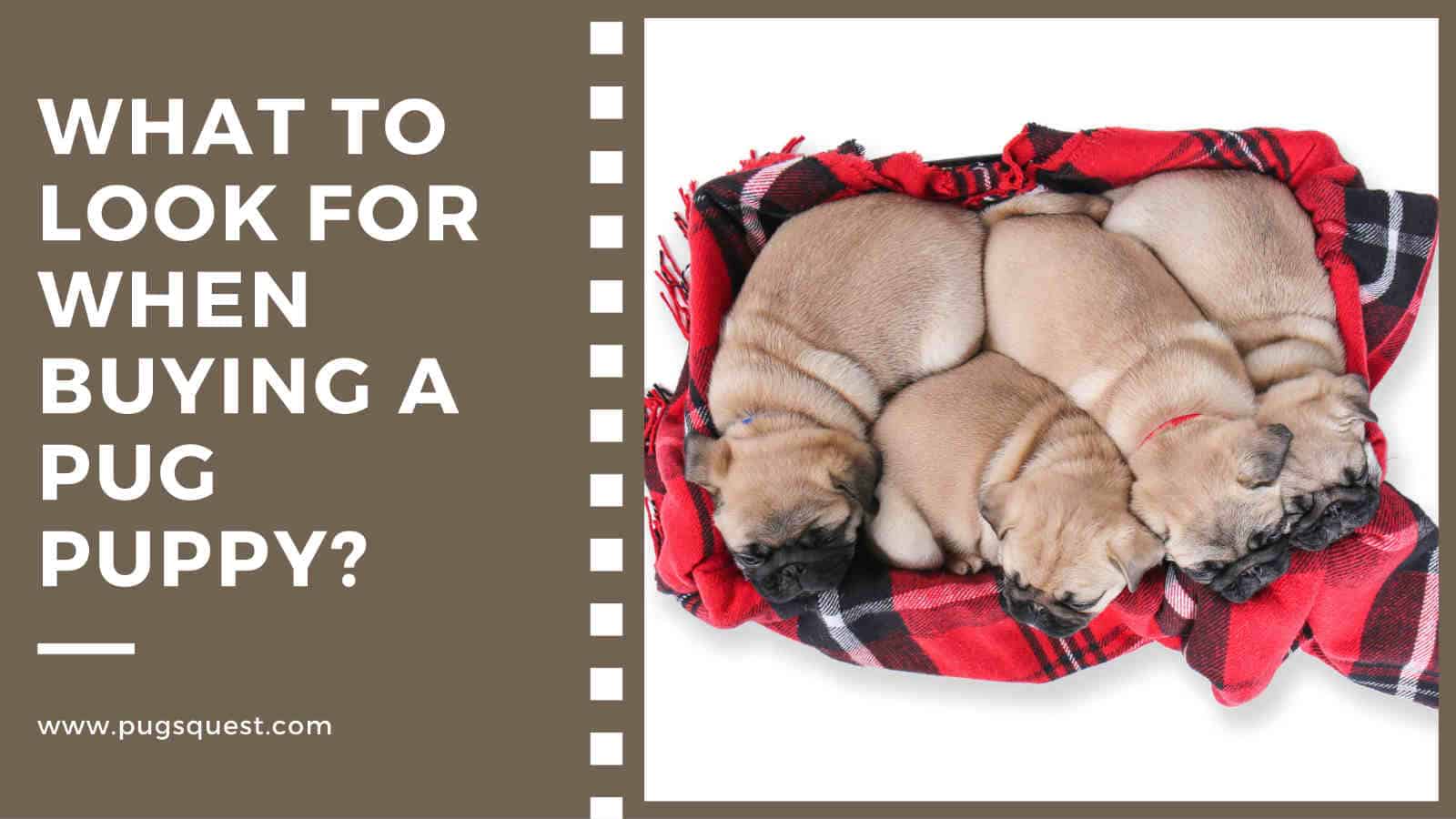
Before buying a Pug puppy you’ll want to make sure you’re ready to take on a new member of the family. And you’ll need to make sure that you’re buying a healthy, happy pup from a reputable breeder. I know this sounds like a lot. But don’t worry. We’re here to help.
We’re going to run you through everything you need to look for when buying a Pug puppy from the red flags to the gold stars.
What Should You Ask Yourself Before Buying a Pug Puppy
Now, let’s take a step back for a moment.
Before we can even start thinking about what to look for in a breeder and a pup, we need to reflect on ourselves. As enticing and exciting as getting a gorgeous new pup is, we’ve got to be responsible. It’s time to ask yourself, is a puppy right for me and my family right now?
Deciding to buy a Pug is a long-term commitment. Pugs need amble love and care. It’s okay to decide that now isn’t the best time to get a pup. In fact, sometimes that is the right thing to do. Before even looking up breeders, ask yourself a few questions.
1. Do you have time for a Pug puppy?
Having a Pug puppy is time-consuming. They need feeding, toilet training, socializing, and a LOT of attention.
2. Can you afford a Pug puppy?
A Pug puppy is a large financial commitment. It’s not just a case of being able to afford the downpayment. Your puppy will need food, vet bills, and toys at the minimum. Not to mention doggy daycare and pet insurance.
3. Is your house and garden pup ready?
You’ll need to secure your house and garden before your new arrival comes home. Puppies are notorious chewers. As they grow they become more curious.
That means wires chewed, vases broken, cushions destroyed, socks stolen… you get the idea.
Aside from the obvious amusement (and frustration), it’s important to realize that some objects around the house are actually going to be dangerous for your pup.
You’ll need to remove any dangerous objects from your house and puppy-proof your garden by ensuring a secure perimeter and removing any hazards.
4. Are you aware of Pug’s health conditions?
Pugs are vulnerable to a number of health conditions. Even Pugs from reputable breeders will have certain genetic predispositions.
It’s important to be prepared for this as an owner.
As a brachycephalic breed, Pugs are particularly prone to developing breathing problems. They are also vulnerable to eye conditions such as eye proptosis, hip dysplasia, and behavioral issues (principally separation anxiety).
Other common health issues include:
- Allergies
- Demodicosis
- Distichiasis
- Elongated palate
- Entropion
- Stenotic nares
- Hemivertebra
- Keratoconjunctivitis sicca (KCS)
- Legg-Perthes disease
- Nerve degeneration
- Patellar luxation
- Pug dog encephalitis (PDE)
- Seizures
- Skin infections
When Buying a Pug Puppy: How to Pick The Perfect Pug Breeder
Decided that you are ready for a Pug?
That’s great news. You’re one step closer to meeting your new puppy pal.
Now it’s time to find a breeder.
Finding a reputable breeder is one of the most important steps in your Pug adoption journey. Not all breeders are made equal. To ensure you’re bringing home a healthy, happy pup you’ll want to pick a well-esteemed breeder who follows all breeder best practices.
Here are some key criteria to consider when looking for a Pug breeder.
1. Seek out reputable breeders
Chances are your first port of call is going to be Google. Unless you have a reputable Pug breeder in your books already then it’s time to play detective. Start your search locally by checking local classifieds online.
You may also want to ask around in your local area. Friends, newspaper ads, the local veterinarian are all great options.
If you’re struggling to find Pug breeders in your immediate vicinity, then check with your regional/ national dog club.
The Pug Dog Club and the American Kennel Club will have a database of reputable, accredited dog breeders.
Signs of a reputable breeder include:
- They’ll welcome you to visit
- They will only breed one or two breeds
- They won’t have anything to hide
- They will ask you a lot of questions (they want to make sure that you are a good match for their precious pups – this is a sign that they genuinely care about their dog’s welfare and want them to go to good, loving homes).
2. Look for clues in the adverts
Sometimes you’ll be able to tell if a breeder is legit, just from the advert. A reputable breeder will include details and pictures of their pups and dam. They will also provide ample information and include details of health testing, conformation, and any after-sales policies.
It’s also worth checking their website. Check to see how many litters they have produced in the last 12 months or so. Good breeders breed less. If the breeder you’re looking into has multiple recent litters advertised then this is a red flag.
3. Assess the personality of the breeder
When you eventually speak with your prospective breeder (on the phone or in person), you’ll be able to get a better feel for them.
Sometimes your gut instinct is the best way to find a reputable breeder. You’ll be able to tell if they are genuine and put their pups first.
A good breeder will be happy to answer any and all of your questions and have ample knowledge of the Pug breed.
If they seem defensive, secretive, or callous, then walk the other way.
4. Do they follow breeder best practices?
When it comes to your first visit, be vigilant. Make sure that your breeder is following breeder best practices. If the breeder doesn’t want you to visit the pups then this is a sign that they are trying to cover up a puppy mill or trying to scam you (we’ll get into this next).
Breeder best practices coverage, health, conformation, and after sales policy. Your breeder should not let their puppies go to new homes before 8 weeks of age. You should never buy a Pug younger than this. Your breeder should provide proof of relevant health checks, conformation, and provide you with an after-sales policy.
5. Beware puppy scams and red flags
Unfortunately, the world is full of puppy scams. Some people who claim to be dog breeders are after one thing and one thing only. Your money. But don’t worry, as long as you do sufficient research you should have no problem avoiding these scams.
Key signs that your alleged breeder is a scam artist:
- They promise a free puppy
- They promise a highly discounted puppy
- They sell sob stories
- They keep asking you for more money
- They are very far away
6. Watch out for puppy mills
Puppy mills aren’t necessarily scammers but they are still best avoided. Even if you feel sorry for the puppies in these mills, the best way to stop this practice is not to fund it by purchasing a puppy from them.
Puppy mills are large-scale breeders who breed pups in poor conditions. Oftentimes pups from puppy mills develop physical and behavioral health issues later in life.
We also recommend avoiding purchasing puppies from pet stores. It’s not uncommon for pet stores to source their puppies from puppy mills.
Buying A Healthy Pug Puppy: What to Look For
When visiting your prospective pug puppy, it’s important to look for signs of good health. Not all health conditions are visible or immediately obvious.
But nonetheless, there are some basic checks you can observe to ensure that your Pug is in top-notch condition.
1. Eyes
Your puppy’s eyes should be bright and clear. Cloudiness, redness, gunk, and discharge are all signs of ill health. Likewise, a Pug with watery, squinted eyes may also be unwell. It’s also worth checking mom’s eyes. If her eyes are also glazed over or irritated then this could be a sign of a hereditary ocular disease.
2. Ears & nose
Look out for any odors, gunk, discoloration, inflammation, or redness around the pup’s ears and nose. These are all causes for concern.
3. Breathing
Listen carefully to the pup’s breathing. Your puppy should be able to breathe comfortably when at rest. Any uncalled for raspiness or breathing difficulties are signs of ill health.
4. Coat
Pug puppies should have super shiny, clean coats.
5. Frame
Pups should be slightly plump with a well-proportioned frame. Shorter than average legs are a sign of a genetic condition called Dwarfism. Unfortunately, Pug Dwarfism is a serious issue and often leads to a myriad of health issues and a short life expectancy.
6. Gait
Check pup’s gait. Look for signs of limping or unsteadiness. Listen out for any clicking sounds from the hips. These are all signs of future joint problems.
How to Pick The Right Pug From a Litter
Once all the health checks are complete, it’s time to pick your new best friend.
Since puppies come in a litter, oftentimes there will be more than one to choose from. And if you’re anything like me, when faced with all those cute wrinkly faces, you’ll just want to take them all home!
Try to pick a pup with a well-balanced temperament. Not too shy and not too crazy. Think about what kind of character will fit best with your home life.
- Is your household mellow and quiet or busy and noisy?
- Do you have kids?
- Do you have other pets?
If after all that you’re still not sure, why not let your Pug pick you!
Questions to Ask a Breeder When Buying Pug Puppies
Not sure what questions to ask the Pug breeder when you call or visit?
No problem.
We’ve put together this go-to list of important questions to ask your prospective breeder.
Remember, a reputable breeder will be happy to answer any of these questions and be adequately knowledgeable.
1. Ask how many litters the mother has had
Pug moms shouldn’t be bred more than once a year. Even that is a bit excessive.
Overbreeding is a serious problem and can lead to health issues for both mom and pups in the long run.
2. Ask who the puppies’ parents are
Ask who the pup’s parents are.
Your breeder should be able to provide you with proof of any relevant health checks and notify you of any hereditary issues.
To avoid hereditary issues it’s best to buy a puppy from older parents.
This is because some genetic health issues do not show up until later in life (usually after approximately three years of age). It is wholly in your right to ask to see the parents in person.
It won’t always be possible to see the father but you should definitely be able to see the mother. In fact, the pups should all be with their mother until at least 8 weeks.
3. Ask where the puppies are living (and ask to see them)
A good breeder will keep their pups in the home. They will be more than happy to show you around.
If the pups are in a dark, cold, isolated area such as a garage or yard – or if the breeder refuses your request to visit- then this is a big red flag.
4. Ask if the puppies have been regularly handled
Make sure that your puppy has been well socialized with people. In the best-case scenario, your pup will have had contact with people of various ages and possibly even other dogs and animals. Adequate socializing is super important for preventing any behavioral issues later in life.
5. Ask for proof of the pup’s veterinary checks
Your pup should have had some initial veterinary checks and vaccinations.
A good breeder will be able to give you a detailed medical history for each pup. All puppies should have been checked by a vet before being homed.
6. Ask for references or to speak to a previous buyer
Good breeders will be happy to provide references.
If people have had a good experience with them in the past, they will be more than happy to offer a reference.
If your breeder refuses to offer you a reference then this is a big warning sign.
7. Ask for a contract
Make sure you and the breeder sign a contract before you take your new pup home.
You shouldn’t have to ask for this. A good breeder will always present new owners with a contract prior to purchase.
The contract should include all breeder and owner responsibilities and any details of a returns policy. Some breeders will even offer a 1-2 year health guarantee against genetic defects.
This means that you’ll be able to return your pup if it has an inheritable disorder or serious health condition.
How To Avoid Puppy Scams
When you are trying to buy a Pug, Puppy scams are an unfortunate reality. They’re out there to get your deposit but have no intention of delivering your precious pup at the end.
Don’t fall for a Pug puppy scam!
In order to avoid scam artists, there are a few tell-tale signs that you can look out for. These are major red flags. Reputable breeders who love their Pugs will never do these things.
Signs of a puppy scam include:
- Promises of a free puppy
- Promises of a highly discounted puppy
- Asking for money just to complete paperwork
- Offering long-distance puppy delivery
Sob stories are a huge red flag. If you come across an advert selling you a pup on the basis of a tragic life event (e.g. owner died) be careful. Whilst this is not always a scam, puppy scam artists do like to use this method.
Usually, if somebody can no longer look after their beloved dog, they will not ask for a lot of money to rehome them. In fact, oftentimes, the dog will be offered to a loving home for free.
Bring Your Pugs Home!
It’s time to bring your Pug puppy home. Sourcing your new Pug pup can be a lengthy process.
Now you know what to look for when buying a Pug puppy, and the tips and tricks to filter the right Pug breeders.
At the end of the day, you’ll have a beautiful, healthy Pug to love for years to come.
You might be interested in…
Best Pug Breeders Near Me: How And Where To Find Pug Puppies For Sale [2021]

